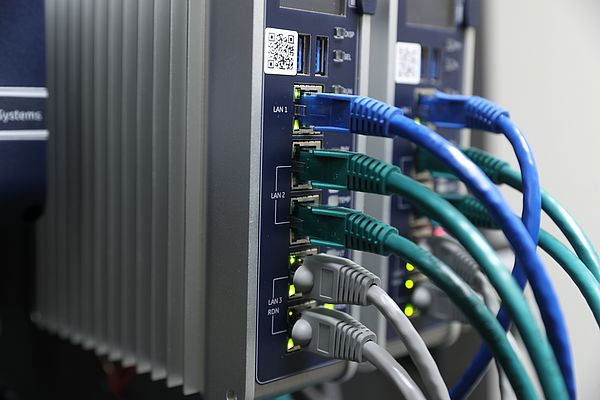The recent emergence of Industry 4.0 and advancements in electronic components have helped those traditional tool sets become a lot smarter by adding cloud connectivity, cybersecurity and distributed processing power, amongst other things. This new convergence of technology has created an opportunity when it comes to problem-solving functionality, operational insight, and the implementation of new techniques. This opportunity is realised in an industrial automation space we refer to as “the edge.”
Industrial edge control
Powerful computers have now merged with the CPU of a traditional industrial automation control system to provide 2-in-1 devices that are physically the size of a paperback book. This means that the same device that controls your machine or process has an onboard, cloud-capable computer to provide new on-machine functionality, such as analytics.
While control systems have historically been connected to computers, these were generally separate workstations or servers that were most likely located in an office far from the machine. This perpetuated the concept of an office IT network that is separate from the OT (operations technology) plant floor network. However, a combined computing and control device provides companies with new opportunities for storage, analysis, processing power and cloud connectivity right at the machine, or edge.
Smarter control
Companies with a computer running at the edge can benefit by controlling their machine or process in a smarter way. Traditional PLC/DCS have some limitations in programming languages, but a computer provides more powerful computing and processing functionality. Advanced algorithms can be processed on the outer loop or computer side of the edge controller box and passed back to the real-time inner loop control system to provide an extra smart control loop. This enables a new form of advanced processing power in a tiny form factor.
Simplified local data storage
The computer side of the edge-enabled controller box allows a local data historian to be run for storage of the real-time data that is generated on the PLC side of the box. This provides the flexibility of local machine data that could be analysed right at the source or connected to a plant-wide historian server for centralised storage if that is preferred. Of course, local storage will help with better execution of machine learning and optimisation algorithms.
Reduced complexity
With a computer inside the edge-enabled controller box, companies don’t have to buy an external computer to see what’s going on in a machine. Peripherals can simply be connected to the ports available on the controller box. Connecting a local display is as easy as plugging in a cable. This simplifies the computer requirements across the plant and gives users hardened industrial devices that provide maximum reliability. A single edge controller device can control a machine, connect to a cloud storage service, store data, run complex algorithms, get real-time visibility and provide a platform for real-time decision-making.
Cloud connectivity
Implementing a cloud strategy is no longer complex. Using an edge-enabled control system, the automation system on your machine can be easily connected to a cloud storage service in just a few minutes. This new generation of control products has taken away any mystery that existed in getting this done, so instead of thinking about how to connect, you can instead consider what to connect. The ability to connect a machine status to the outside world enables new business models through connectivity to remote fleet, corporate, expert or market data.
Connecting machines and processes to the cloud offers companies a number of potential opportunities and benefits. For example, one of the easiest ways to identify an improvement opportunity is to compare similar assets from different locations and to benchmark their performance. An under-performing asset is easy to identify using basic KPIs and raising its performance level can bring quick improvement.
Collecting data from sensors on a machine provides a long-term picture of its performance against the original design theory. Determining real-world failure modes and thresholds can then help to improve future designs and brings competitive advantages for the OEM. Sensor data can also be used to build a digital history of performance and machine health. Algorithms can then be developed that use real-time sensor data to create alerts for domain experts located anywhere in the world should performance deviate from optimum levels or equipment health degrade.
Having self-diagnosed machine health or status, edge controllers can connect to a cloud solution that uses GPS and geofencing to alert an appropriately skilled technician closest to site to repair the problem as quickly as possible. Edge controllers can help to enhance multi-organisation collaboration, such as manufacturers and raw material suppliers. The opportunity to connect to third parties’ systems such as off-site supply chain systems, as well the onsite MES or ERP, provides an easy means of digital collaboration between different organisations, ensuring transparency and greater efficiency.
As well as data being sent to the cloud, it can also be received. A cloud-based algorithm can collect data from multiple sites and use powerful centralised processing to run the master algorithm of the company. The result can send data to a controller that can improve production or reduce costs. An example of this could be a cloud algorithm checking live energy tariffs and sending a message to the controller to run pumps or motors when the energy price is low.
By combining some of these functionalities, new business models emerge. OEMs can create new value for their customers by offering new types of service agreements. Raw material suppliers can differentiate themselves by accepting stricter contractual terms with their customers as a result of effective real-time business critical information. Automation system integrators can expand their businesses by offering new and differentiated cloud-based services. Industrial plant monitoring centres could become a new industry as more and more machines get connected.
By Daniel Coetzee, EMEA Commercial Director in Industrial Automation and Control Solutions at Emerson



















